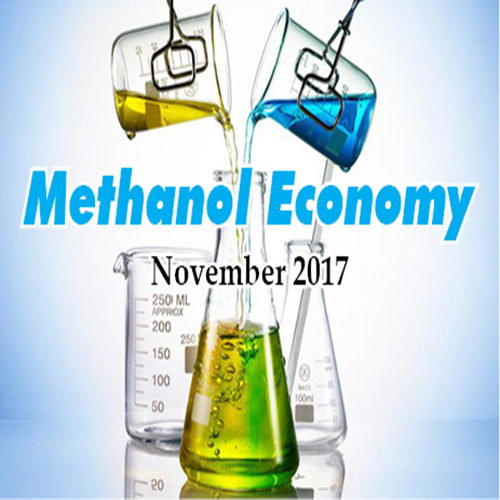A high percentage of fuels produced are used for transportation and most of these like petrol and diesel are from oil & gas. Since long, particularly after sudden oil price hikes, the world has been searching for suitable alternatives. Since 1990s, methanol has been advocated as a viable alternative as it is a good carrier of energy. In this overview, the various developments, the potential and prospects are well presented.
Though India’s methanol economy is yet to take off from the drawing boards, it has begun to make waves in popular media in last few months. Methanol Economy is hardly a new concept, having been advocated as far back as 1990s by the Chemistry Nobel Laureate George Olah. But how we and probably China perceive this new paradigm is different from the way rest of the world does.
Transport Fuel
The attractiveness of methanol as a clean and efficient substitute for petrol is quite well known. Pure methanol has been used as the fuel in the popular Indy Car Races in USA since 1965, primarily from safety considerations. From 1980 to 2005, USA ran a successful methanol campaign, in which tens of thousands of vehicles were converted to operate on M85, consisting of 85% methanol. But in 2005 USA abandoned methanol in favour of crop-based ethanol, in what was clearly a political decision. That leaves China as the biggest user of methanol for transportation. Contributing 55% to the global production, China produces 47 million tonnes of methanol annually. Methanol is blended with petrol in various proportions ranging from 5% to 100%, 15% being the most common. Geely, a Chinese company, has emerged as the world’s leading methanol vehicle manufacturer, with a capacity to produce 200,000 vehicles per annum. China has a current stranglehold on the methanol economy, dominating both production and consumption.
Fuel Cells
But blending with petrol is at best a pitstop on the long and arduous journey of methanol. Many countries, India, France, Britain and Norway among them, have declared their plans to junk internal combustion engine in favour of electric vehicles. India has set an ambitious target of 2030 for going fully electric. How does this stack up with the adoption of methanol economy? The answer is fuel cell.
Electric-powered vehicles have two options to source their power: Battery or Fuel Cell. For long, opinion has been divided equally among experts on which is a better option. But in a survey by KPMG early this year, Fuel Cells found an overwhelming backing from automobile companies, because they don’t need a charging infrastructure. And among Fuel Cells, it is the Direct Methanol Fuel Cell (DMFC) that has the power to propel the methanol economy forward. Invented in 1990s by a host of institutions, including NASA, the DMFC uses an acidic solid polymer, in the form of a membrane, as the electrolyte. Methanol and water react electrochemically to generate power. The DMFC is ideal for transport application compared to the bulky hydrogen based fuel cells because of its high energy density and quick refueling. Daimler Chrysler unveiled the first DMFC powered vehicle in 2000. In 2015, Denmark opened the first methanol refilling station to service DMFC fitted vehicles. However, the efficiency of DMFC is currently poor and improvements are required on the catalysts that make up the electrodes.
Dimethyl Ether
Another potential application of methanol exciting the Indian think tank is using it for production of dimethyl ether (DME). DME has properties that are remarkably similar to LPG. China, the world’s largest producer of DME, used it widely to blend with LPG. But this practice was banned in 2008, following safety concerns. The blended fuel was found to damage the rubber sealants of the LPG cylinders. Despite the ban, the blending of LPG with DME continues to be rampant. DME has also been used as a substitute for diesel with limited success; the issues being poor engine lubrication.
Methanol
At the heart of the Methanol Economy is its production. It is important to remember that methanol is not the source of energy, but only its carrier. Energy derived from other sources, primarily coal, natural gas and biomass, is converted and stored in methanol. The efficiency of this energy conversion process is central to the success of methanol economy. China produces 85% of it methanol from coal and the remaining from natural gas. India also wants to put coal at the centre of its methanol economy. Syngas for methanol synthesis is obtained from natural gas by steam reforming. Coal and biomass have to be gasified first and then cleaned up before syngas can be produced. China has experimented with different types of gasifiers and has a very mature coal gasification technology. India on the other hand has struggled to establish the gasification technology for its high-ash coal. Both coal and natural gas would only be transition fuels before we move on to biomass in order to meet the renewable energy goals of Paris agreement.
Biomethanol
It is the renewable feedstocks that perhaps pose the biggest threat to the methanol economy. The conversion efficiency of biomass to methanol is presently in the range of 50-60%. Biomass gasifiers are available in various designs like fixed bed, fluidised bed, entrained bed etc. These have been successfully demonstrated for locally available biomass. Scale-up, cost reduction and ability to handle diverse feedstocks are key challenges. Another potential threat comes from the still-maturing technology for producing ethanol from cellulosic biomass. Ethanol continues to be lobbied hard in USA. Water consumption is significantly lower for methanol production than ethanol, even after accounting for the methanol’s lower energy density.
Methane Hydrates
No overview of methanol economy can be complete without reference to methane hydrates, deposits of which are believed tobe a larger source of energy than that combined from oil, gas and coal. The current estimate of methane trapped in gas hydrate deposits is in the order of 105 trillion cubic meters, 99% being in ocean sediments. While commercial production of methane from gas hydrates is at least a decade away, a mature Methanol Economy can immensely profit from it. Much research is underway for the biological oxidation of methane to methanol using methanotrophic bacteria.
Holy Grail
The Holy Grail of Methanol Economy would be to capture carbon dioxide from the atmosphere and convert it to methanol. Such a process is indeed feasible and has been patented by George Olah and his team. Hydrogen required to react with carbon dioxide can be generated electrolytically from water using renewable solar energy, for example. This will make Methanol Economy carbon-neutral and truly circular.
Post Script – This column is dedicated to the memory of George Olah, the champion of Methanol Economy, who passed away in March this year.
Readers’ responses may be sent
to k.sahasranaman@gmail.com or
































